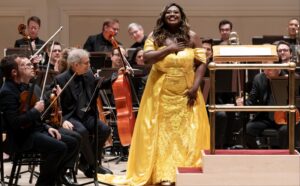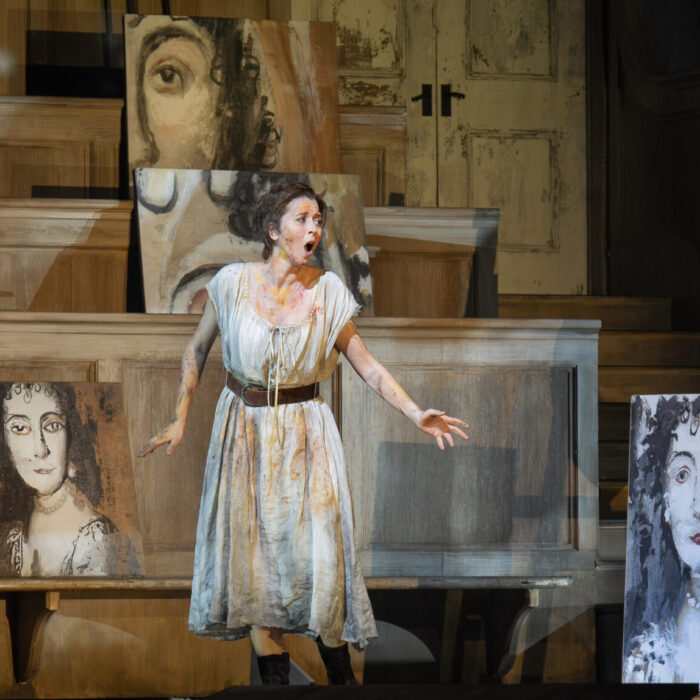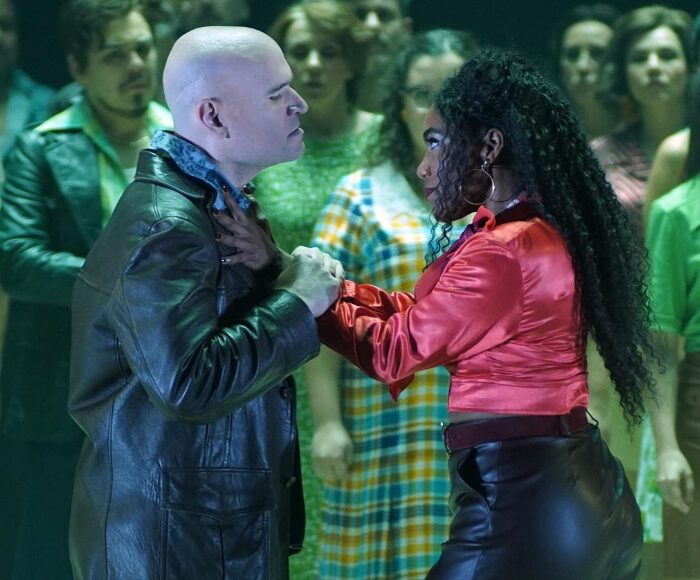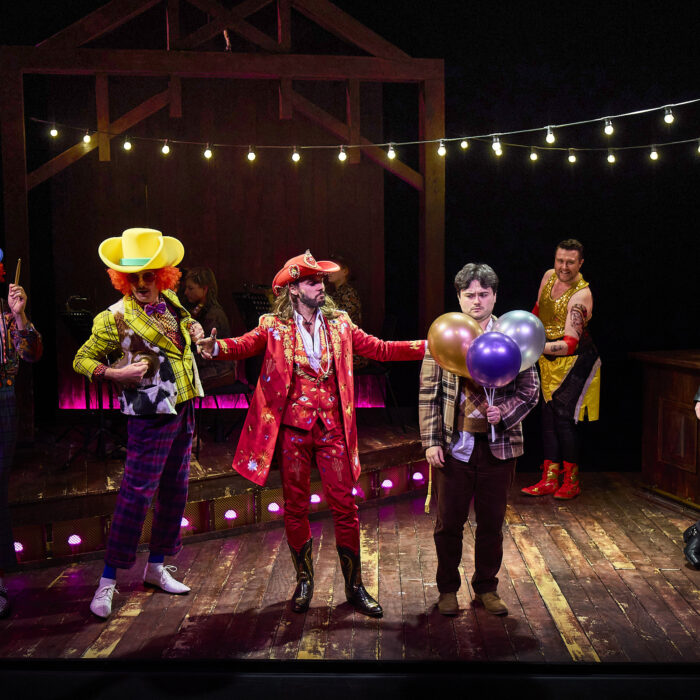
Carnegie Hall 2025 Review: Soprano Angel Blue & The Met Orchestra
Conductor Nézet-Séguin Showcases the Met Orchestra’s Spectacular Talent Featuring Incredible Performance by Angel Blue
By Jennifer Pyron(Photo: Jennifer Taylor)
The Met Orchestra celebrated its second night of a two-part series at NYC’s Carnegie Hall on Wednesday, June 18, 2025 with a packed house. The evening’s performances included exciting works by Gabriela Ortiz, “Antrópolis” (2018; rev. 2019) with principal timpanist Parker Lee, Leonard Bernstein‘s Symphony No. 1 “Jeremiah,” featuring soprano Angel Blue, Terence Blanchard‘s NY Premiere of his Orchestral Suite from “Fire Shut Up in My Bones” (2019; arr. 2024), and Antonín Dvořák‘s elating Symphony No. 9 in E Minor, Op. 95, “From the New World” (1893).
Antrópolis (2018)
The opening for this evening began with Gabriela Ortiz’s “Antrópolis.” It was a vibrant display of dance music that filled Carnegie Hall with joy and excitement! Ortiz initially had ideas about this work while driving with her husband at night and talking about all the different music one can hear when traveling to nightclubs and dancing to the music. The world premiere of this work took place on April 1, 2018 at the Palacio de Bellas Artes, Mexico City with the Orquesta Sinfónica Nacional de México and Mexican conductor Carlos Miguel Prieto. The Met Orchestra’s performance, especially the timpani solo played at the beginning by Principal Timpanist Parker Lee, was outstanding. Conductor Nézet-Séguin visibly showed his enthusiasm and his musicality matched the high energy driving this work by showing the wide range of dynamics and playfulness that really is what makes the Met Orchestra most special. One could see the smiles on the musicians faces while audience members swayed in their seats about ready to pop up and start dancing. Ortiz’s musical ear for gathering so many compositional ideas and packing them into “Antrópolis” is unique and highly intelligent. It is one thing to showcase an array of dance themed styles of music, while it is completely something else to make one piece a seamless yet very complex design of enriching rhythms, collaborations and solos.
Jeremiah (1942) Featuring Soprano Angel Blue
Leonard Bernstein’s Symphony No. 1 “Jeremiah” is described by Bernstein as a “‘Hebrew song’ for soprano and orchestra, based on a text from the Book of Lamentations.” The Leonard Bernstein Office also states that: “With ‘Jeremiah,’ Bernstein not only established himself as a major American symphonist, he began a musical and dramatic exploration of a theme that would continue to inspire many of his major works throughout his career.”
“‘The work I have been writing all my life,’ he said in 1977, ‘is about the struggle that is born of the crisis of our century, a crisis of faith.’ While ‘Jeremiah’ offers only consolation and not a solution to this crisis, Bernstein’s creative journey through ‘The Age of Anxiety’ (1949), ‘Kaddish’ (1963), ‘Chichester Psalms’ (1965) and, finally, ‘Mass’ (1971), led him to a profound conclusion—that a renewal of faith in modern times requires a return to innocence, a shedding of the trappings of dogma and orthodoxy, and a fundamental belief in our common humanity.”
American soprano Angel Blue is a two-time Grammy Award winner, 2020 Beverly Sills Award recipient, and the 2022 Richard Tucker Award winner. Her most recent performances include the role of Violetta in Verdi’s “La Traviata” at Arena di Verona and a concert with Christoph Gedschold at the Tivoli Festival in Copenhagen, Denmark. Blue is also very well-known for her performance in three roles as Destiny, Loneliness, and Greta in Terence Blanchard’s “Fire Shut Up in my Bones” Met debuted 2021. OperaWire interviewed her in August 2024 and readers can learn more from this conversation at this link.
A recent impression of Blue’s voice was documented in OperaWire’s coverage of Paola Prestini and Royce Vavrek’s foley chamber opera, “Silent Light.” Angel Blue’s performance during Bernstein’s “Jeremiah” was very moving, however it was difficult to experience all of her presence because she was placed behind the orchestra on stage right. For me, when I witnessed her in “Silent Light” there was an embodied voice that sets Blue’s singing apart from other singers right now. I wanted to see her more, and hear her more on this night at Carnegie Hall. Overall, conductor Nézet-Séguin really did impart his special attention on Blue, making sure the orchestra did not overpower her while she was singing because “Jeremiah” does have a spaciousness and resonance that filled Carnegie Hall with ease and dramatic emotion that is typical of Bernstein’s beloved works. This piece in particular made a strong impression with its vastness and while Blue was singing her voice definitely utilized its full spectrum of sound and palette of colors. I just wanted to see Blue up front because I wanted to experience more of her beautiful presence. She is one of the best sopranos today because of who she is and when she sings this shines through like a beacon of light. It’s also important to note how her stunning yellow dress that she wore on this night was breathtaking, but I couldn’t see it until she took her bows at the end of the piece.

(Photo: Jennifer Taylor)
Terence Blanchard’s NY Premiere of his Orchestral Suite from “Fire Shut Up in My Bones” (2019; arr. 2024)
Terence Blanchard and Kasi Lemmons’ opera, “Fire Shut Up in my Bones,” made history in 2021 as the first opera presented at Met Opera by a Black composer. OperaWire reviewed this work on opening night and readers can learn more at this link. The opera is based on the autobiographical book by Charles M. Blow and follows the internal/external trials and tribulations of a young man faced with the aftermath of a traumatic and abusive childhood. Terence Blanchard’s musical journey of this young man’s discoveries while navigating his life is legendary. Blanchard’s use of jazz blended with classical traditions and enthusiastic dynamism made his new Orchestral Suite, premiered on this night at Carnegie Hall, something fresh and alive, reconsidering the power of his opera’s emotional and nostalgia induced cravings.
The effect Blanchard’s music had on so many when it first debuted at the Met was iconic and so to experience his Orchestral Suite, encapsulating its most iconic moments, included melodies that still play in the back of one’s mind: ‘Peculiar Grace,’ ‘A place where you can be just by yourself,’ and ‘Sometimes you gotta just leave it in the road.’
It must have felt revolutionary for conductor Nézet-Séguin to usher in this new work again. At the helm of all understanding surrounding this piece is consciousness and awareness, which is exactly what I felt as I observed the Met Orchestra playing and following Nézet-Séguin’s lead. There was a sense of reverence during this work, stemming from a celebration of Blanchard’s new score but also a resistance as joy aimed at our current United States administration. The reality of our world is the reality. However, for just a moment in time and in this space that is Carnegie Hall, one might feel hope returning, clarity lifting the veil of fear, and joy as a fire reigniting internally to fuel us all to remember this most magical night of musical storytelling that is “Fire Shut Up in my Bones.”
From the New World (1893)
Antonín Dvořák’s epic Symphony No. 9 in E Minor, Op. 95, “From the New World” (1893) is a feat for any orchestra to play well. The Met Orchestra took on this musical challenge and delivered a performance that felt historical and timely. Conductor Nézet-Séguin’s work and leadership with the orchestra has bridged a connection with the musicians can be felt during every performance. There is a knowing that exudes from their playing together, making audience members feel excited and on the edge of their seats with hopeful expectations. For me, experiencing the Met Orchestra playing Dvořák’s work was monumental emotionally. I have deep ties to this piece and it felt like a lot of other audience members, and especially the musicians, did too. This is one of those works that tests the skills and intuition of an orchestra. It is a painting using all the colors and a landscape full of depths and heights insurmountable. Nézet-Séguin’s intelligent marking of tempo and dynamism with his orchestra made this final work of the evening feel like it had just been played for the first time. The audience stood in ovation and applause for every section.
“From the New World” was composed by Dvořák during his residency in the United States between 1892 and 1895. It is full of rhythms that leave listeners wanting to learn more and so on the research behind this symphony one can see how Dvořák pulled rhythms from multiple cultural influences. The English horn melody also plays an important role in this work, which the program states how “one of his pupils later turned it into the spiritual-like song ‘Goin’ Home.'” Dvořák’s compositions and catalogue of works influenced many during his time that still resonates with us today.
The Met Orchestra sounded splendid and really made this second night at Carnegie Hall for their 2024-25 season a special celebration that leaves one feeling great expectations for their new season ahead.



